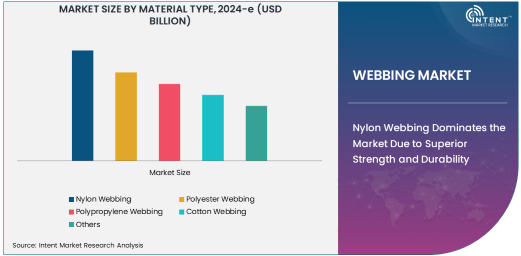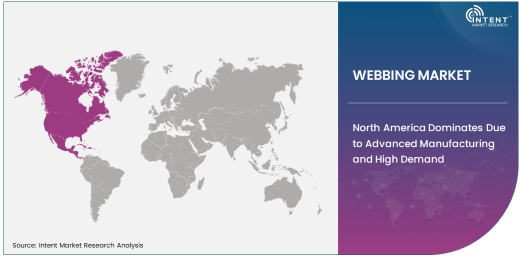As per Intent Market Research, the Webbing Market was valued at USD 1.6 billion in 2024-e and will surpass USD 3.3 billion by 2030; growing at a CAGR of 12.4% during 2025 - 2030.
The webbing market is witnessing significant growth, driven by its widespread application across various industries such as automotive, textile and apparel, sports, and military. Webbing, a versatile fabric made by weaving fibers like nylon, polyester, or cotton, is valued for its strength, durability, and flexibility. The increasing use of webbing in safety gear, straps, belts, and industrial equipment highlights its indispensable role in both commercial and specialized applications.
Nylon Webbing Dominates the Market Due to Superior Strength and Durability
In the material type segment, nylon webbing holds the largest share owing to its exceptional tensile strength, elasticity, and resistance to wear and tear. Nylon webbing is extensively used in industries such as automotive for seatbelts, military for tactical gear, and sports for harnesses and equipment.
Its ability to withstand extreme conditions and heavy loads makes it a preferred choice for critical applications. Additionally, nylon webbing's smooth texture and adaptability to various finishes enhance its usability in consumer-facing products like apparel and accessories, further fueling its market dominance.

Non-Elastic Webbing Sees High Adoption for Stability-Centric Applications
Within the product type category, non-elastic webbing emerges as the largest segment due to its stability and strength. Non-elastic webbing is extensively used in applications requiring fixed support and rigidity, such as load-bearing straps, industrial safety equipment, and vehicle tie-downs.
The superior resistance of non-elastic webbing to stretching under pressure ensures long-term reliability, making it essential for heavy-duty uses. Its cost-effectiveness and compatibility with advanced manufacturing techniques contribute to its widespread adoption across industries.
Automotive Industry Leads as Largest End-Use Sector
The automotive industry holds the largest share in the end-use industry segment, driven by the extensive use of webbing in safety features like seatbelts, cargo restraints, and interior designs. As automotive manufacturers prioritize safety and durability, webbing's role in meeting stringent regulatory requirements and enhancing passenger protection is critical.
The growing demand for electric vehicles and lightweight materials further accelerates the adoption of webbing, which offers high strength-to-weight ratios. Webbing's versatility in adapting to innovative designs and sustainability trends positions it as an essential material in modern automotive manufacturing.
North America Dominates Due to Advanced Manufacturing and High Demand
North America stands as the leading regional market for webbing, attributed to advanced manufacturing capabilities, high safety standards, and the region's strong presence in automotive and defense industries. The U.S., in particular, drives market growth with substantial investments in military-grade webbing and increasing demand from the outdoor and leisure sectors.
The region's focus on innovation and eco-friendly materials further supports the development and adoption of webbing products, ensuring its continued leadership in the global market.

Competitive Landscape: Innovation and Sustainability Take Center Stage
The webbing market is highly competitive, with key players like E. Oppermann GmbH, Murdock Webbing Company, and Narrowtex focusing on innovation and sustainability. Manufacturers are investing in advanced technologies to produce high-performance webbing that meets evolving industry requirements, including lightweight, flame-resistant, and biodegradable options.
Collaborations and product expansions are key strategies shaping the market landscape. Companies are also exploring the integration of smart materials and coatings to enhance webbing's functionality, ensuring it remains a vital component across diverse applications. As industries prioritize safety, efficiency, and sustainability, the webbing market is poised for sustained growth.
Recent Developments:
- In November 2024, W.L. Gore & Associates launched a new range of webbing materials designed for military and aerospace applications.
- In October 2024, Saint-Gobain expanded its webbing production capabilities with a new facility in Asia to cater to growing demand in the automotive sector.
- In September 2024, Bally Ribbon Mills introduced a new polyester-based webbing line for high-strength applications in heavy-duty machinery.
- In August 2024, 3M Company unveiled an eco-friendly webbing option made from recycled materials aimed at the textile and fashion industries.
- In July 2024, E. I. du Pont de Nemours and Company announced a partnership with a leading medical equipment manufacturer to develop specialized webbing solutions for healthcare applications.
List of Leading Companies:
- Saint-Gobain
- W.L. Gore & Associates, Inc.
- Ahlstrom-Munksjö
- Bally Ribbon Mills
- Narrowtex
- Weber, Inc.
- E. I. du Pont de Nemours and Company (DuPont)
- Trelleborg AB
- Lift-All Company
- Strapworks
- 3M Company
- The Seatbelt Shop
- Sioen Industries
- DogBuckle
- Zhejiang Mufeng Weaving Co., Ltd.
Report Scope:
|
Report Features |
Description |
|
Market Size (2024-e) |
USD 1.6 billion |
|
Forecasted Value (2030) |
USD 3.3 billion |
|
CAGR (2025 – 2030) |
12.4% |
|
Base Year for Estimation |
2024-e |
|
Historic Year |
2023 |
|
Forecast Period |
2025 – 2030 |
|
Report Coverage |
Market Forecast, Market Dynamics, Competitive Landscape, Recent Developments |
|
Segments Covered |
Webbing Market By Material Type (Nylon Webbing, Polyester Webbing, Polypropylene Webbing, Cotton Webbing), By Product Type (Elastic Webbing, Non-elastic Webbing), By End-Use Industry (Automotive, Textile and Apparel, Sports and Leisure, Military and Defense, Healthcare) |
|
Regional Analysis |
North America (US, Canada, Mexico), Europe (Germany, France, UK, Italy, Spain, and Rest of Europe), Asia-Pacific (China, Japan, South Korea, Australia, India, and Rest of Asia-Pacific), Latin America (Brazil, Argentina, and Rest of Latin America), Middle East & Africa (Saudi Arabia, UAE, Rest of Middle East & Africa) |
|
Major Companies |
Saint-Gobain, W.L. Gore & Associates, Inc., Ahlstrom-Munksjö, Bally Ribbon Mills, Narrowtex, Weber, Inc., E. I. du Pont de Nemours and Company (DuPont), Trelleborg AB, Lift-All Company, Strapworks, 3M Company, The Seatbelt Shop, Sioen Industries, DogBuckle, Zhejiang Mufeng Weaving Co., Ltd. |
|
Customization Scope |
Customization for segments, region/country-level will be provided. Moreover, additional customization can be done based on the requirements |
|
1. Introduction |
|
1.1. Market Definition |
|
1.2. Scope of the Study |
|
1.3. Research Assumptions |
|
1.4. Study Limitations |
|
2. Research Methodology |
|
2.1. Research Approach |
|
2.1.1. Top-Down Method |
|
2.1.2. Bottom-Up Method |
|
2.1.3. Factor Impact Analysis |
|
2.2. Insights & Data Collection Process |
|
2.2.1. Secondary Research |
|
2.2.2. Primary Research |
|
2.3. Data Mining Process |
|
2.3.1. Data Analysis |
|
2.3.2. Data Validation and Revalidation |
|
2.3.3. Data Triangulation |
|
3. Executive Summary |
|
3.1. Major Markets & Segments |
|
3.2. Highest Growing Regions and Respective Countries |
|
3.3. Impact of Growth Drivers & Inhibitors |
|
3.4. Regulatory Overview by Country |
|
4. Webbing Market, by Material Type (Market Size & Forecast: USD Million, 2023 – 2030) |
|
4.1. Nylon Webbing |
|
4.2. Polyester Webbing |
|
4.3. Polypropylene Webbing |
|
4.4. Cotton Webbing |
|
4.5. Others |
|
5. Webbing Market, by Product Type (Market Size & Forecast: USD Million, 2023 – 2030) |
|
5.1. Elastic Webbing |
|
5.2. Non-elastic Webbing |
|
6. Webbing Market, by End-Use Industry (Market Size & Forecast: USD Million, 2023 – 2030) |
|
6.1. Automotive |
|
6.2. Textile and Apparel |
|
6.3. Sports and Leisure |
|
6.4. Military and Defense |
|
6.5. Healthcare |
|
6.6. Others |
|
7. Regional Analysis (Market Size & Forecast: USD Million, 2023 – 2030) |
|
7.1. Regional Overview |
|
7.2. North America |
|
7.2.1. Regional Trends & Growth Drivers |
|
7.2.2. Barriers & Challenges |
|
7.2.3. Opportunities |
|
7.2.4. Factor Impact Analysis |
|
7.2.5. Technology Trends |
|
7.2.6. North America Webbing Market, by Material Type |
|
7.2.7. North America Webbing Market, by Product Type |
|
7.2.8. North America Webbing Market, by End-Use Industry |
|
7.2.9. By Country |
|
7.2.9.1. US |
|
7.2.9.1.1. US Webbing Market, by Material Type |
|
7.2.9.1.2. US Webbing Market, by Product Type |
|
7.2.9.1.3. US Webbing Market, by End-Use Industry |
|
7.2.9.2. Canada |
|
7.2.9.3. Mexico |
|
*Similar segmentation will be provided for each region and country |
|
7.3. Europe |
|
7.4. Asia-Pacific |
|
7.5. Latin America |
|
7.6. Middle East & Africa |
|
8. Competitive Landscape |
|
8.1. Overview of the Key Players |
|
8.2. Competitive Ecosystem |
|
8.2.1. Level of Fragmentation |
|
8.2.2. Market Consolidation |
|
8.2.3. Product Innovation |
|
8.3. Company Share Analysis |
|
8.4. Company Benchmarking Matrix |
|
8.4.1. Strategic Overview |
|
8.4.2. Product Innovations |
|
8.5. Start-up Ecosystem |
|
8.6. Strategic Competitive Insights/ Customer Imperatives |
|
8.7. ESG Matrix/ Sustainability Matrix |
|
8.8. Manufacturing Network |
|
8.8.1. Locations |
|
8.8.2. Supply Chain and Logistics |
|
8.8.3. Product Flexibility/Customization |
|
8.8.4. Digital Transformation and Connectivity |
|
8.8.5. Environmental and Regulatory Compliance |
|
8.9. Technology Readiness Level Matrix |
|
8.10. Technology Maturity Curve |
|
8.11. Buying Criteria |
|
9. Company Profiles |
|
9.1. Saint-Gobain |
|
9.1.1. Company Overview |
|
9.1.2. Company Financials |
|
9.1.3. Product/Service Portfolio |
|
9.1.4. Recent Developments |
|
9.1.5. IMR Analysis |
|
*Similar information will be provided for other companies |
|
9.2. W.L. Gore & Associates, Inc. |
|
9.3. Ahlstrom-Munksjö |
|
9.4. Bally Ribbon Mills |
|
9.5. Narrowtex |
|
9.6. Weber, Inc. |
|
9.7. E. I. du Pont de Nemours and Company (DuPont) |
|
9.8. Trelleborg AB |
|
9.9. Lift-All Company |
|
9.10. Strapworks |
|
9.11. 3M Company |
|
9.12. The Seatbelt Shop |
|
9.13. Sioen Industries |
|
9.14. DogBuckle |
|
9.15. Zhejiang Mufeng Weaving Co., Ltd. |
|
10. Appendix |
A comprehensive market research approach was employed to gather and analyze data on the Web Webbing Market. In the process, the analysis was also done to analyze the parent market and relevant adjacencies to measure the impact of them on the Web Webbing Market. The research methodology encompassed both secondary and primary research techniques, ensuring the accuracy and credibility of the findings.
.jpg)
Secondary Research
Secondary research involved a thorough review of pertinent industry reports, journals, articles, and publications. Additionally, annual reports, press releases, and investor presentations of industry players were scrutinized to gain insights into their market positioning and strategies.
Primary Research
Primary research involved conducting in-depth interviews with industry experts, stakeholders, and market participants across the E-Waste Management ecosystem. The primary research objectives included:
- Validating findings and assumptions derived from secondary research
- Gathering qualitative and quantitative data on market trends, drivers, and challenges
- Understanding the demand-side dynamics, encompassing end-users, component manufacturers, facility providers, and service providers
- Assessing the supply-side landscape, including technological advancements and recent developments
Market Size Assessment
A combination of top-down and bottom-up approaches was utilized to analyze the overall size of the Web Webbing Market. These methods were also employed to assess the size of various subsegments within the market. The market size assessment methodology encompassed the following steps:
- Identification of key industry players and relevant revenues through extensive secondary research
- Determination of the industry's supply chain and market size, in terms of value, through primary and secondary research processes
- Calculation of percentage shares, splits, and breakdowns using secondary sources and verification through primary sources
.jpg)
Data Triangulation
To ensure the accuracy and reliability of the market size, data triangulation was implemented. This involved cross-referencing data from various sources, including demand and supply side factors, market trends, and expert opinions. Additionally, top-down and bottom-up approaches were employed to validate the market size assessment.
NA
